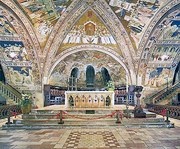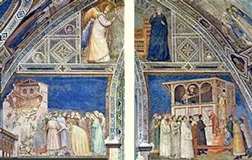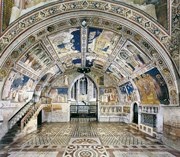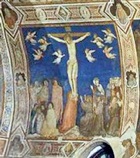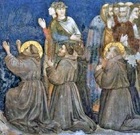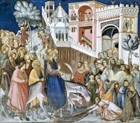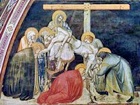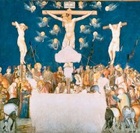As set out in the page on the Lower Church, the redecoration of the transepts of the lower church seems to have begun in the late 13th century, shortly after demolition of the original choir screen. The programme began with the right transept, shortly after the erection of the Cappella di San Nicolò. It seems to have involved three distinct phases of work (as described in more detail in the page on San Francesco in the 14th Century):
-
✴Phase I, which comprised the frescoes of the Cappella di San Nicolò and the upper part of the exterior surface of its entrance wall (i.e. the back wall of the right transept). These frescoes are attributed to Giotto and his workshop, and seem to pre-date his frescoes (1305) in the Arena Chapel, Padua. They may well have been carried out during the tenure of Brother John of Morrovalle as Minister General (i.e. in 1296-1304): Giorgio Vasari reported that it was he who called Assisi.
-
✴The iconographical programme for the redecoration of what had been the friars’ choir was probably decided upon during the General Chapter meeting at Assisi in 1304.
-
✴Phase II of the redecoration, which was probably also carried out in ca. 1305-11, involved:
-
•most of the right transept;
-
•the apse and crossing vaults; and
-
•the Cappella di Santa Maria Maddalena (which is entered by the opening in the right wall of the right transept).
-
These frescoes are also reasonably securely attributed to Giotto and his workshop, but they seem to post-date the frescoes of the Arena Chapel, Padua (1305). It seems likely that the work was financed by the loan that Palmerino di Guido repaid in Assisi in 1309 on his own behalf and that of “Giotto Bondoni of Florence”.
-
✴Phase III, which seems to have been carried out in 1317-19, mostly by Pietro Lorenzetti, involved:
-
•the fictive altarpiece of the Cappella di San Giovanni Battista, off the back wall of the left transept (which was the pendant chapel to the Cappella di San Nicolò);
-
•the left transept itself; and
-
•the frescoes above the Altars in the Left and Right Transept.
Frescoes of the Right Transept
Phase I
The frescoes on the upper part of the back wall of the right transept (which, as noted above, formed the entrance wall to the Cappella di San Nicolò) depict:
-
✴the Annunciation (above); and
-
✴two scenes of the posthumous miracle in which St Francis revived a youth from Suessa after he had been killed when a house collapsed ( “Tractatus de Miraculis” 2:45, “Legenda Maior”, Appendix on the Miracles of St Francis 2:6). The miracle scenes were probably chosen because they were on the entrance wall of the funerary chapel of a young man (Giovanni Gaetano Orsini) who had been killed in an accident.
Phase II
There seems to have been a hiatus before Giotto and his workshop returned to complete the frescoes of the back wall of the right transept.
The frescoes in the top two registers of the barrel vault depict scenes from the early life of Christ:
-
✴the Visitation and the Nativity (top register on the right);
-
✴the Adoration of the Magi (illustrated here) and the Presentation in the Temple (second register on the right);
-
✴the Flight into Egypt and the Massacre of the Innocents (top register on the left); and
-
✴Christ among the Doctors and His return to Bethlehem (second register on the left).
The frescoes in the bottom register of the left wall depict: a miracle in which St Francis revives a dead child; and the triumph of St Francis over death. These fit more naturally in iconographical terms with the frescoes of the apse and crossing vaults, and are therefore described on that page.
The original fresco by Cimabue in the bottom register of the right wall was cut down at this time but otherwise left in tact.
The Crucifixion to the left of it has St Mary Magdalene (the titular of the adjacent chapel) at the foot of the cross, with St John the Evangelist and the swooning Virgin among the figures to the left.
A small group of friars kneel to the right. Two of them (probably SS Francis and Antony of Padua) have haloes. However, a third, who kneels between them, has no halo. He seems to have been painted from life, suggesting that he had been closely involved in commissioning the work. There is no basis for his identification: however, he could be Brother
John of Morrovalle, whom Pope
Boniface VIII had created cardinal bishop of Porto in 1302 and who had resigned as Minister General during the General Chapter at Assisi in 1304.
Work then proceeded to the frescoes of the apse and crossing vaults, which were left uncompleted in ca. 1311.
The frescoes associated with the altars on the right wall, which were executed in Phase III, are described on the page on the Altars of the Lower Church.
Frescoes of the Left Transept
Phase III
The frescoes of the left transept were executed in a continuous campaign, starting with the barrel vaults and ending with the back wall. They were first attributed to Pietro Lorenzetti in 1864, and this attribution almost immediately gained general acceptance. Pietro Lorenzetti may have been called to Assisi by Cardinal Napoleone Orsini in ca. 1317 in order to paint the frescoed altarpiece of the Cappella di San Giovanni Battista. Pietro Lorenzetti probably left Assisi when Muzio di Francesco seized control of Assisi in 1319: most scholars consider that the the last frescoes that he painted at Assisi (the Deposition and the burial of Christ - see below) immediately pre-dated the polyptych that Bishop Guido Tarlati of Arezzo commissioned in 1320.
The majority of the frescoes belong to a cycle of scenes from the Passion of Christ:
-
✴the Entry of Christ into Jerusalem (illustrated here) and the Last Supper (top register on the right);
-
✴Christ washing the feet of a Disciple; and the Capture of Christ (second register on the right);
-
✴the flagellation of Christ and the road to Calvary (top register on the left);
-
✴the Deposition (illustrated here) and the burial of Christ (second register on the back wall); and
-
✴Christ’s descent into limbo and the Resurrection (top register on the back wall).
The Crucifixion is depicted in the third register of the left wall, forming a pendant to that in the opposite transept. This magnificent work contains about fifty figures, each strongly differentiated. [Longinus depicted twice ??] The fresco was damaged when an altar was installed here in 1607. Fra Ludovico da Pietralunga (referenced below) recorded that soldiers casting lots for the clothes of Christ were depicted at the foot of the cross. The offending altar was removed in ca. 1870.
Most of the other frescoes in the left transept were also executed in Phase III:
-
✴The frescoes in the bottom register of the right wall depict:
-
•the suicide by hanging of Judas (to the left of the door at the top of the stairs); and
-
•the stigmatisation of St Francis (to the right of this door).
-
These fit more naturally in iconographical terms with the frescoes of the apse and crossing vaults, and are therefore described on that page.
-
✴The frescoes associated with the altars on the right wall, which, are described on the page on the Altars of the Lower Church.
Read more:
R. Brooke, “Image of St Francis: Responses to Sainthood in the 13th Century”, (2006) Cambridge (pp 428-39)
B. Zanardi, “Giotto and the St. Francis cycle at Assisi”, in
A. Derbes et al. (Trans), “Cambridge Companion to Giotto”, (2003) Cambridge (Ch 3).
This is an English version of the core of Zanardi’s thesis, which he has also published in more extensive articles in Italian.
H. Maginnis , “Pietro Lorenzetti: A Chronology”, Art Bulletin 66 (1984), pp. 183-211
P. Scarpellini, “Fra Ludovico da Pietralunga: Descrizione della Basilica di San Francesco d’ Assisi”, (1982), Treviso
H. Maginnis, “Assisi Revisited: Notes on Recent Observations”, Burlington Magazine, 117 (1975) pp. 511-517
Return to the Lower Church.
Return to the main page on San Francesco.
Return to Walk III.
Return to the home page on Assisi.


